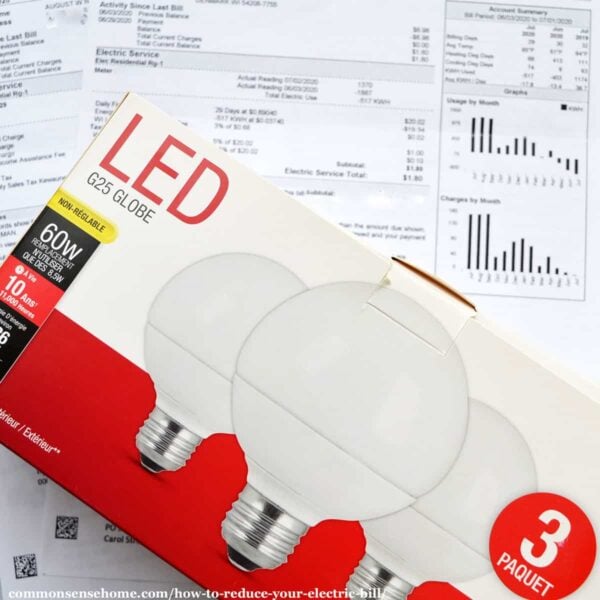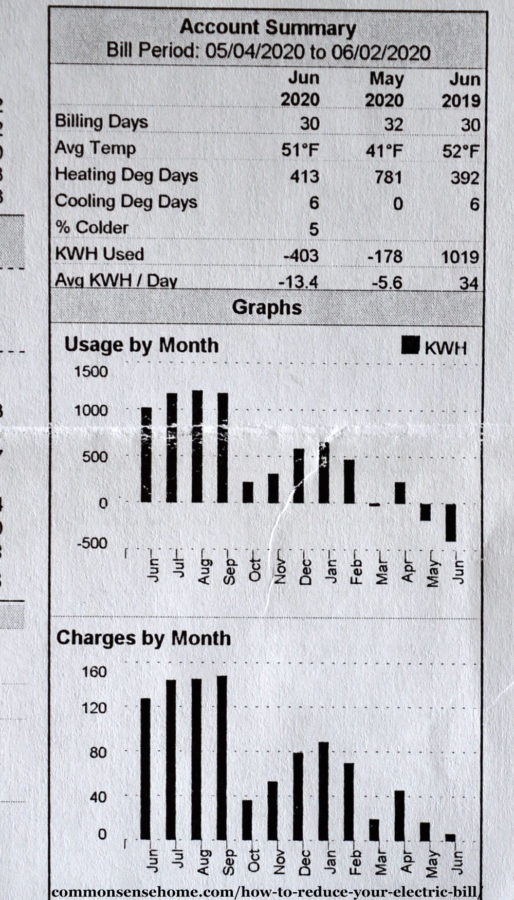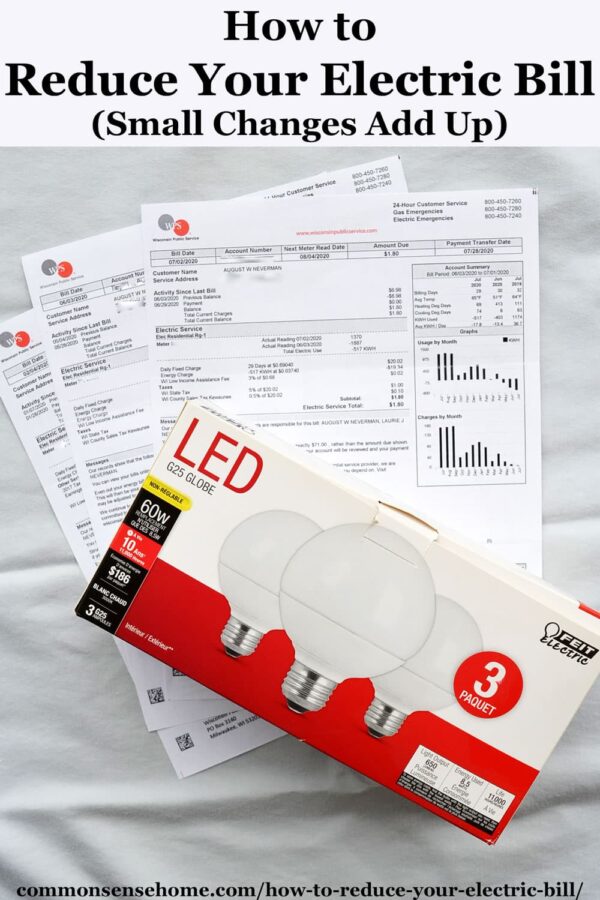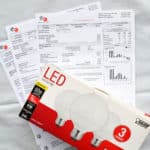How to Reduce Your Electric Bill (Small Changes Add Up)
Energy costs are going up, and many areas of the country face increased rick of power outages this summer. We'll help you reduce your electric bill and save energy – without completely changing your lifestyle. There are tips for year round and seasonal suggestions.
Before you get started with changes that reduce energy consumption, read your electric bills from the last year or so. Figure out if you use more power during different seasons, or you load is similar year round.
If your load is always high, then it's not just the air conditioning or heating. Compare your energy bill before and after you make changes.

Ways to Reduce Electricity Use
The easiest and fastest way to reduce your electric bill is by turning off things when not in use. Whether it's lights, electronics, appliances or anything else that requires electricity usage – turn it off if you don't need it.
Sometimes flipping the “off” switch isn't enough. Why? Because of phantom loads.
What is phantom loading?
“Phantom load” is the electricity used by a device when it is appears to be turned off. Phantom loads are also known as standby power or vampire loads.
Examples:
Leaving a USB phone charger plugged in wastes electricity, because it still draws power, even when it's not charging a phone.
Most “smart” TVs and other smart devices draw electricity when turned off, because they are waiting for the signal to turn on, or connecting to the internet for updates.
Does unplugging appliances save electricity?
Unplugging makes a difference! If you are not sure if a device is drawing electricity when it should not be, just unplug it.
If plugs are hard to reach, or you want to unplug a group of items at one time, use a power strip. Turn the strip off, or unplug it. (If a power strip has a light on it, it still draws some power.) Don't forget wifi networks – they draw power, too.
If you decide to unplug your computer or other electronics at night, make sure to allow time for needed software updates. Run updates just before shutting down for the night to keep security and software patches up to date.
Energy Efficient Lighting Options
- Replace incandescent and CFL/fluorescent lights with LED lighting. LEDs (light emitting diodes) use up to 82% less electricity than an incandescent bulb of the same lumens. They also last up to 25 times longer.
- Use natural lighting wherever possible. Sunlight is free. If you are in a hot climate, install shades that reflect heat but let light in.
- Clean/dust light bulbs and fixtures. Dusty light bulbs can reduce brightness (lumens) by as much as 50%. Dust can also reduce the life of light bulbs, costing you more because you have to replace them more frequently.
- Add dimmer switches so you only turn on as much light as needed. Note, dimmer switches can increase EMF levels, so be careful if you are sensitive to EMFs.
- Use a timer or motion sensor so a bathroom light or closet light goes off as soon as a person is not there any more. Timers are great for bathrooms vents, too.
- Put exterior lights on a motion sensor instead of leaving them on all night, or switch exterior yard lights to solar.
- Skip holiday lights, use LED lights, or switch to solar for holiday lights. Put them on a timer instead of running them all night.
What reduces your electric bill more?
Everything adds up, but you'll quickly notice some things have a much bigger impact in reducing your electric bill than others.
For example, a bathroom might have FIVE Incandescent 40 watt “round” bulbs that use 200 watts when on. If you switch those five lights to 7 watt LED light bulbs, your power usage drops from 200 watts vs 35 watts per hour.
If you spend one hour in the bathroom per day, this adds up to over 60 kilowatt-hours (60,000 watt-hours) per year of energy saved.
USB chargers pull from 0.1 to 0.05 watts per hour, with nothing plugged in. Over a year, this adds up to around 430 to 870 watt-hours. They also create heat, which makes your air conditioning work harder. More chargers equals more electricity use and more heat.
If you plug chargers in only when in use, you can drop the load to around 100 – 200 watt-hours per year.
This is a significant percent decrease, but saving 60,000 watt-hours with new light bulbs will reduce your electric bill more than saving 600 watt-hours by unplugging a charger.
You can get an electricity usage monitor like the Kill-a-Watt to identify big electric loads. Just plug in the device and read the numbers.
Cooking Tips that Reduce Your Electric Bill
- Cooking outside reduces your air conditioning load. If you use a solar cooker, you don't need to buy any fuel.
- If it's an option, consider a propane or natural gas stove, which are normally cheaper to operate than electric stoves.
- Match the pot or pan to the size of the burner on your stove. If the burner is bigger than the pot or pan you will lose heat.
- Cover a pot or pan to make the contents cook faster (which will use less energy).
- Thaw frozen foods completely (in the fridge) before cooking so you use less energy heating the frozen item.
- If making toast with a toaster oven, use a shorter toast cycle and let the toast sit in the toaster after it finishes. The heat trapped in the toaster will finish the browning, saving a small amount of energy.
- You can use the same trick with stove top and oven cooking. Turn the stove off a little bit early, and the residual heat will finish the cooking.
- Cook larger quantities at once and reheat. Generally reheating uses less energy than cooking in the first place.
- Consider a pressure cooker like the InstantPot. It can cook food in about one-third the time of the oven or stovetop. Cooking with a gas or propane stove may still be cheaper than an electric pressure cooker, so compare costs if you have a non-electric stove.
- Use insulated cookers like a wonder oven to slow cook foods with minimal heat.
Refrigerators and Freezers
- A top opening chest freezer is far more efficient than a stand up, front opening freezer. The chest freezer gains far less heat when it is opened and gives you roughly 20% more usable space.
- Put foods you want to thaw in the fridge, before you need the food. The frozen food will help keep the fridge cold while it thaws.
- Only open the refrigerator or freezer or oven door only when you need something. Don’t let the heat (or cold) come out.
- Let hot foods cool before you put them in the fridge.
Washing Clothes (and People)
- Reduce hot water use with shorter showers (or cold showers). Use cold water setting in your washing machine when possible. Every gallon of water not heated is a reduced electric bill or gas bill.
- Do full loads of laundry (or dishes) not partial. The electricity cost is effectively the same if it is a ½ load vs a full load.
- Dry clothes on a clothes line or drying rack instead of using a dryer (especially an electric dryer). Replace an electric dryer with a natural gas or propane dryer. Electricity tends to be more expensive per BTU (watt).
Heating, Ventilation and Cooling (HVAC)
- Get a programmable thermostat or smart thermostat for your HVAC system. Avoid heating or cooling your home or apartment when you are not home. Choose temperature settings that are closer to ambient temperatures outside.
- Clear/clean/replace air filters as needed.
- Seal leaky windows that let in cold in winter and let out the cool in summer.
- Clean cold air returns and vents
- Make sure radiators, vents, returns or baseboard heaters are NOT blocked by furniture, carpeting or drapes.
- Make sure vents are open (or closed) correctly for the time of year.
- Close vents and doors to unused rooms.
Cooling Tips
- It nighttime temps are cooler than temps inside the house, open the house at night to cool down. Dropping the temperature at night as much as possible reduces the air conditioning load during the day.
- Close up windows and close shades during daytime heat, keep the cold in and heat out.
- Add Energy Star approved ceiling fans to provide cooling breezes.
- Get Air Conditioners (A/C) checked regularly.
- Close chimney flue and/or fresh air feed for any fireplaces to avoid heat gain.
- For new construction or remolding, consider overhangs for east, south and west windows.
See “12 Best Tips for Keeping Your House Cool without AC” for more detailed information.
Heating Tips
- Consider switching away from electric heating. Natural gas, propane and/or wood are usually more affordable.
- Increase insulation in attic and walls, if possible.
- In rural areas add windbreak tree line to reduce winter wind heat loss.
- Get insulating blinds and close the blinds during the night and during dark cold days to reduce heat loss. Drapes will help some as a less expensive alternative. For a storm, a blanket can be used to cover a window temporarily to reduce heat loss.
- Get heating professionally checked at least annually.
- Add storm windows or window insulating clear sheets.
- Create an airlock so you don't open the house directly outside. (Come inside through an attached garage or porch.)
- Close the chimney flue and/or fresh air feed to a wood burning stove when it is not in use.
See “25 Cheap Ways to Keep Your House Warm in Winter” and “Best Ways to Keep Your House Warm – New Construction and Remodeling Tips” for more ideas.
Should I use Propane/Natural Gas or Electric Heater?
In most cases propane (LPG – liquid propane gas) or natural gas (NG) is cheaper for a house heater, stove, dryer or water heater. You need to calculate costs BTU vs Watts to make sure.
Solar Electricity
Solar electricity is expensive, but it can pay off if you have enough sun, can get tax credits and your utility will buy excess power. Remember, solar power only works when the sun is out and the panels are clear of shade, ice and snow.
Most utilities only pay a fraction of what they charge you for electricity for the energy that you produce. For instance, we pay over 12 cents per KWH when we buy electricity, but the utility only pays us 3 cents per KWH when they buy our extra electricity.

What About Electric Cars?
Remember if you have or plan to purchase an electric or hybrid vehicle, you will consume significantly more electricity. Off peak electric pricing might be a good fit to reduce your electric bill, because you can charge at night when rates are cheaper.
Reducing Your Electric Bill with Off Peak Pricing
Some power companies offer “on peak” and “off peak” pricing. They charge lower electric rates during certain night hours, but MORE during the day or “Peak Hours”.
If you can time your usage carefully, this may reduce your electric bills. It also helps the utility to reduce their load during their heaviest draw times.
Off peak hours are typically 10pm to 7am, but you will need to confirm with your electric utility company for all the details. Not all locations or utility companies offer “Off Peak” options.
Tips for New Homes or Remodeling
- Put wall electrical outlets on a switch so you can turn off anything on the plug or even on the circuit.
- Replace appliances and devices with high efficiency versions. Many refrigerators, TVs, washers, dryers and other electronic devices or motors are far more efficient. When buying look for Energy Star label.
- Buy energy efficient appliances. Look for the ENERGY STAR label, which is a federal guarantee the thing will use less energy. ENERGY STAR clothes washers consume 25% less energy and 45% less water than conventional ones; refrigerators 9% less energy than the conventional.
- Split electricity into a CRITICAL panel and a MAIN panel. The CRITICAL panel should have heating, cooling, refrigerator, freezer, well pump, etc. The MAIN panel can have all the other stuff that is not absolutely necessary.
- Add a generator power feed ahead of time with a double/pull double/throw switch to the generator so you can power your CRITICAL panel. This way if there is an extended power outage, you can get power to the most important things.

You may also like these Related Articles
- Emergency Power Options for Your Home – Gas Generators and More
- What to Do When the Power Goes Out (12 Things to Prepare)
- 10 Reasons the Power Grid Fails
- Do Battery Powered Space Heaters or Emergency Heaters Exist?


Question. What about hot water heaters? I currently have the old standard tall drum looking kind. My cousin recently installed the tankless kind. One better than the other?
That’s a bit more complicated. I was actually talking to our plumber about this recently (chatting while he was repairing the urinal). He said that on paper, it looks like tankless water heaters are great, in the field they don’t tend to perform that well.
Water tanks are normally quite well insulated, so you don’t lose much heat from that warm water hanging around for when you need it. In northern climates, any “lost” heat is not an issue most of the year because the house needs the warmth anyway.
When the tankless heaters kick on, they draw a LOT of power (if you have the electric ones). Years ago, I remember watching the electric meter spin when one was in use. It was impressive – and not in a good way.
Both the gas and electric tankless heaters tend to have issues with mineral fouling over time, which reduces efficiency and eventually leads to the unit needing to be replaced. Replacing the unit more frequently tends to wipe up any small savings it might have achieved. The old standard water heaters will normally have much longer lives.
Thanks for running this post again. We are looking through the recommendations with the eyes of 2023.
This week’s challenge: We have a small flock with the oldest hen entering her 4th year, and the youngest entering their 3rd year.
In 2020, we ordered Barred Rock chicks and got a gaggle of hens who turned as expected into black and white pullets, but then most of them developed tri-corner combs, a reliable characteristic of Dominiques, a much more amiable breed than Barred Rocks, but with lighter physiologies better suited to southern climates.
We had a Spring and Summer with loads of eggs. We gave our extra eggs to our friends.
Hearing the muttering about fuel issues and higher energy costs, we decided not to give these girls heat this Winter, but increase the amount of insulation on the coop and to only give them a little heat if we got extremely low temps.
We worked on the insulation in November, and heated the coop until it was in place. Our electricity bill for October was $79 . For November it was $115. For December it was $76.
We live in an extremely well insulated, wood stove heated cottage, and we have begun to reduce our energy consumption in as many ways as we can think up. The difference in the lower bill is definitely heating the coop. Last week, our neighbor, who is retired and has cancer called us to ask us if we would sell her some eggs.
Last year, with mostly heat from ceramic infrared heaters, we were getting mostly 4 to 6 eggs per day. We paid about $120 per month for electricity. Our highest bill last Winter was about $220.
This Winter, with no coop heat since the end of November, we have collected 0 to 4 eggs per day. My husband and I are are accustomed to eating 2 or 3 eggs per day in the Winter each.. We are taking turns with egg meals right now.
Last week, our neighbor, who is retired and has cancer called us to ask us if we would sell her some eggs. We had to tell this very nice woman that we literally do not have the eggs to do that. The commercial eggs in our Super One are selling for about $5.00, the organic ones are quite a bit higher, and getting higher.
I am looking in our area for other families with home flocks who might be able to help my friend.
Our community is predominantly made up of older couples who do not, or no longer garden or keep livestock.
I see a lot of heartache ahead, and a need for creativity in getting us through the next few years.
Thanks for the reminder that we can do more. Or perhaps I should say, “Do more with less and some smarter ideas!”
Unless you are emotionally attached to the chickens, it may be time for chicken soup and younger layers. As chickens get older, egg production slows way down, heat or no heat. Our oldest chicken, Miss Mimi, will be 4 years old this year. She looks great right now, but her molt gets longer each year. After her molt last fall, she didn’t start laying again until later December, and now only lays a couple of eggs per week. The younger hens kept laying daily or every other day all winter, without added light or heat.
If the chickens are more like pets, then less eggs are on the menu for the time being.
Thanks for a very helpful, extensive review of energy saving tips. We have taken care of a number of these opportunities including switching to LEDs for just about everything except a couple of spots where we actually want the heat of incandescent bulbs, for example in a homemade water tank heater for our chickens.
I am pretty sensitive to elevated electromagnetic frequencies, a common characteristic of LED light bulbs. We waited almost three years before building our home, which helped us understand and anticipate seasonal
patterns, weather and solar patterns.
Our cottage is small and we often rearrange furniture to suit some of our indoor seasonal work projects. When we move furniture around, we gauge how far my work space needs to be from light fixtures and equipment. We also wired the East and South walls so that our kitchen and main work zones could be wired as you suggested for rapid transition to generator power or to shut down during stormy weather. The corner formed by the West and North walls is where we placed our bedroom. The circuit for that zone is kept off until we need to use equipment kept there.
We use solar charged lights around the bedroom. We got those little flashlights that August recently recommended and like them a lot! We experimented this year with cooking on our wood stove and scheduling the fires so we had enough residual heat to keep us warm through most days with a few hours of wood heat at night. This resulted in significantly lower bills for electricity.
Our walls are rated at R26 walls and our roof at R28 with most of or windows on the South wall so the solar gain is pretty good. We decided against AC units and only regret this for the 3 to 5 days a year above 85F. And darned if there aren’t still risks o take care of, but we keep working at it as we learn more. But we are nearly there!
I remember ‘off peak’ electricity from when I was a kid. Our current utility does not offer that now, but still tend to do laundry and run the dishwasher later at night anyhow.
Heating or cooling, shut off least used rooms. Create ‘zones’ to heat/cool. We have a portable AC unit that cools our main living areas and is only used when the humidity is too much to bear. We otherwise rely on open windows on cool side of house closed windows on hot side and ceiling fans.
August’s parents used off peak rates, and with everyone out of the house most of the day and his mom keeping odd hours due to swing shifts, they managed to make it work fairly well. With us all working from home now, it would be a bit of a pickle. I do try and match to when we have solar water heating and electricity available during the day as much as possible.